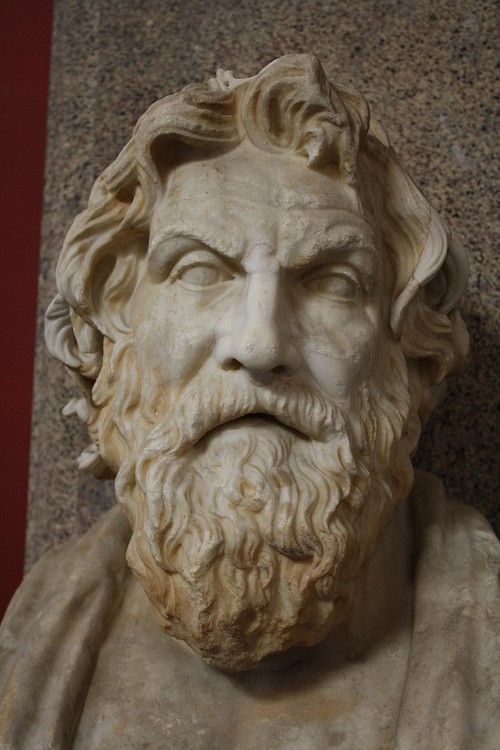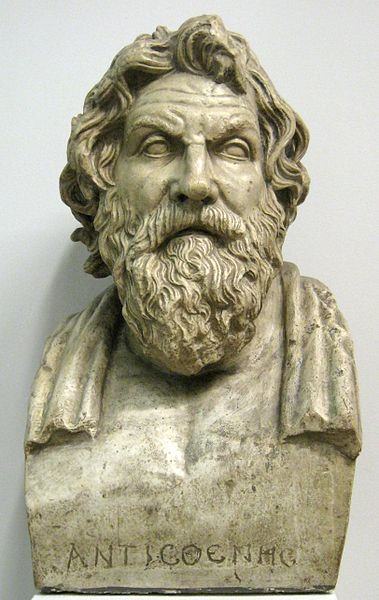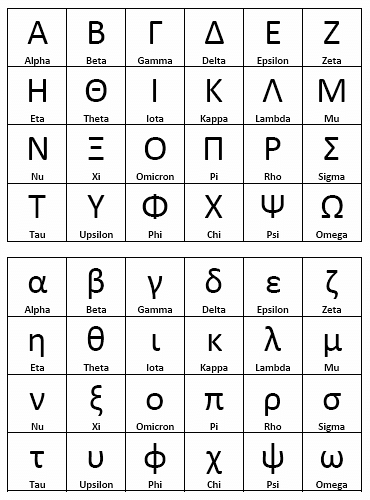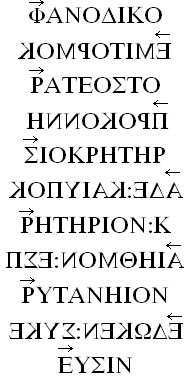Antisthenes of Athens › Greek Alphabet » Ancient origins
Articles and Definitions › Contents
- Antisthenes of Athens › Who Was
- Greek Alphabet › Ancient History
Ancient civilizations › Historical and archaeological sites
Antisthenes of Athens › Who Was
Definition and Origins

Antisthenes of Athens (c. 445-365 BCE) was a Greek philosopher who founded the Cynic School. He was a follower of Socrates and appears in Plato ’s Phaedo as one of those present at Socrates' death. He is one of the primary interlocutors in Xenophon ’s works Memorabilia and Symposium. Antisthenes, like Crito, was among the older students of Socrates' and Charles Kahn writes that he was regarded as Socrates' most important follower (Kahn, 4-5). He believed that virtue could be taught and that only the virtuous were truly noble. It should be noted, however, that `Virtue' here is a translation from the Greek word `arete' which meant something closer to `personal excellence' than the English word `virtue'. In Plato's Meno it was argued that arete could not be taught (else noble fathers would have produced noble sons and such was not, empirically, the case) but Antisthenes argued otherwise in that he had learned arete from Socrates and, therefore, arete could be taught.
INFLUENCE OF SOCRATES
Socrates' students all founded philosophical schools of one kind or another and all of them were so diverse that it is a testimony to the expansive quality of Socrates' philosophy that so many men could interpret his teachings in such different ways. The hedonistic philosopher Aristippus, for example, claimed to be following Socrates' example in living a life in pursuit of pleasure while Plato claimed he was carrying on Socrates' vision through an ascetic discipline of the mind. Antisthenes, also, asserted that his philosophy was grounded in Socrates' original vision. It seems almost impossible, at first, that Aristippus, Plato, and Antisthenes could have had the same teacher, so different are their philosophies at first glance. Underlying all three, however, is that very same virtue which Socrates held so dear: the importance of being free to be true to oneself and one's own convictions in life. The Cynic School Antisthenes founded stressed the importance of prevailing over adversity by acceptance of it, that arete is the same for women as it is for men, and that this personal excellence is displayed in deed more so than in word. These same values, expressed differently, were taught by both Plato and Aristippus.
EARLY LIFE
Regarding his early life, the biographer Diogenes Laertius (3rd century CE) writes:
Antisthenes was an Athenian, the son of Antisthenes. And he was said not to be a legitimate Athenian; in reference to which he said to someone who was reproaching him with the circumstance, "The mother of the Gods too is a Phrygian;"
€style for he was thought to have had a Thracian mother. On which account, as he had borne himself bravely in the battle of Tanagra, he gave occasion to Socrates to say that the son of two Athenians could not have been so brave. And he himself, when disparaging the Athenians who gave themselves great airs as having been born out of the earth itself, said that they were not more noble as far as that went than snails and locusts.Originally he was a pupil of Gorgias the rhetorician; owing to which circumstance he employs the rhetorical style of language in his Dialogues, especially in his Truth and in his Exhortations. And Hermippus says, that he had originally intended in his address at the assembly, on account of the Isthmian games, to attack and also to praise the Athenians, and Thebans, and Lacedaemonians; but that he afterwards abandoned the design, when he saw that there were a great many spectators come from those cities. Afterwards, he attached himself to Socrates, and made such progress in philosophy while with him, that he advised all his own pupils to become his fellow pupils in the school of Socrates. And as he lived in the Piraeus, he went up forty furlongs to the city every day, in order to hear Socrates, from whom he learnt the art of enduring, and of being indifferent to external circumstances, and so became the original founder of the Cynic school (I, II).

Antisthenes Bust
ANTISTHENES THE CYNIC
The focus of Antisthenes' work was ethics (although he also wrote on physics, logic, and literature ) and he seems to have devoted himself extensively to that subject. He also wrote a literary criticism on the Odyssey, an essay on dying, and works dealing with every subject from music to `the uses of wine'. Diogenes Laertius claims there “are ten volumes of his writings extant” though, today, only his Ajax and his Odysseus remain. He is considered the first Cynic philosopher (`cynic' from the Greek for `dog', Kynos, or Kynikos which means dog-like) and, by example, taught Diogenes of Sinope and others, like Crates, how to live truly and shamelessly. Regarding the origin of the name `cynic' Diogenes Laertius writes, “He used to lecture in the Gymnasium, called Cynosarges [meaning place of the white dog] not far from the gates; and some people say that it is from that place that the sect got the name of Cynics. And he himself was called Haplocyon (downright dog).” The word `cynic' did not have the same meaning at the time as it does in the modern day and did not mean `skeptical' or refer to someone who believes human beings are only motivated by self-interest and personal desires, but meant `dog-like' in that the Cynics were thought to live like dogs. Antisthenes and his followers had few possessions beyond their cloaks and bags, lived where they could find shelter, and did not seem to engage in any kind of work. The evolution of the word `cynic' to its present meaning may come from the Cynics' lack of regard for accepted theories on ethics, morality, the gods, and the proper way to live one's life.
THE CYNIC SCHOOL WAS CHARACTERIZED BY THE DISCIPLINE OF SELF-DENIAL AND REJECTION OF UNNECESSARY MATERIAL OBJECTS.
ANTISTHENES OR DIOGENES?
Whether Antisthenes was, in fact, the founder of the Cynic school or whether that honor belongs to Diogenes of Sinope has long been disputed. It is argued that Antisthenes could not have taught both Diogenes of Sinope and Crates of Thebes and impossible that Crates went on to teach Zeno of Citium as he lived long after the deaths of these men. This argument further claims that the disputed chronology was created by the Stoics later in order to link Zeno of Citium's teachings directly back to Socrates. The other side argues that Antisthenes did, in fact, have Diogenes of Sinope and Crates of Thebes as pupils and Crates certainly could have taught and influenced Zeno of Citium. This claim is further disputed by scholars who claim that Diogenes came to Athens after Antisthenes had died and point out that Aristotle refers to the followers of Antisthenes as `Antistheneans' and not as `Cynics'. There is no resolution to this debate in scholarly circles thus far but the majority contend that Antisthenes founded the Cynic School and taught Diogenes of Sinope the Cynic philosophy which found full expression later through Zeno of Citium.

Diogenes of Sinope
THE CYNIC SCHOOL
The Cynic School was characterized by the discipline of self-denial which rejected luxuries, social status, and the acquisition of wealth and unnecessary material objects. It was thought that, by freeing oneself from those social conventions associated with `being someone' that one would be free to become oneself. Since virtue could be taught, and virtue (or, specifically, personal excellence), led to contentment, one could lead the happiest life by placing the pursuit of one's own virtue before all else. Since material gain was seen to often interfere with such a pursuit, it was rejected in favor of the ascetic life. Further, concerns about the future and one's fate were considered superfluous and a needless distraction. Adherents of Antisthenes' philosophy were encouraged to focus on the present and be content with what they had and what they were doing in the present day rather than waste time worrying about what they might be doing or where they might be tomorrow. Regarding Antisthenes' philosophy, Diogenes Laertius writes:
And the doctrines he adopted were these. He used to insist that virtue was a thing which might be taught; also, that the nobly born and virtuously disposed, were the same people; for that virtue was of itself sufficient for happiness. And was in need of nothing, except the strength of Socrates. He also looked upon virtue as a species of work, not wanting many arguments, or much instruction; and he taught that the wise man was sufficient for himself; for that everything that belonged to any one else belonged to him. He considered obscurity of fame a good thing, and equally good with labour. And he used to say that the wise man would regulate his conduct as a citizen, not according to the established laws of the state, but according to the law of virtue. And that he would marry for the sake of having children, selecting the most beautiful woman for his wife. And that he would love her; for that the wise man alone knew what objects deserved love (V).
Antisthenes died in Athens of a disease which may have been consumption. He is said to have borne his illness and impending death with calm and acceptance as simply another part of the life he had so enjoyed and so saw no reason to complain.
Greek Alphabet › Ancient History
Definition and Origins

The Greek alphabet is the writing system developed in Greece which first appears in the archaeological record during the 8th century BCE. This was not the first writing system that was used to write Greek : several centuries before the Greek alphabet was invented, the Linear B script was the writing system used to write Greek during Mycenaean times. The Linear B script was lost around c.1100 BCE and with it, all knowledge of writing vanished from Greece until the time when the Greek alphabet was developed.
The Greek alphabet was born when the Greeks adapted the Phoenician writing system to represent their own language by developing a fully phonetic writing system composed of individual signs arranged in a linear fashion that could represent both consonants and vowels. The earliest Greek alphabet inscriptions are graffiti incised on pots and potsherds. The graffiti found in Lefkandi and Eretria, the 'Dipylon oinochoe' found in Athens, and the inscriptions in the 'Nestor's cup' form Pithekoussai are all dated to the second half of the 8th century BCE, and they are the oldest known Greek alphabetic inscriptions ever recorded.
ORIGIN & DEVELOPMENT OF THE GREEK ALPHABET
During the early first millennium BCE, the Phoenicians, who originated in Lebanon, turned into successful maritime merchants, and they gradually spread their influence westwards, establishing outposts throughout the Mediterranean basin.The Phoenician language belonged to the Semitic branch of the Afro-Asiatic language family, and it was closely related to Canaanite and Hebrew. With them, the Phoenicians carried goods to trade and also another valuable commodity: their writing system.

Nestor's Cup
EVEN THOUGH TODAY THE GREEK ALPHABET IS ONLY USED FOR THE GREEK LANGUAGE, IT IS THE ROOT OF MOST OF THE SCRIPTS USED TODAY IN THE WESTERN WORLD.
The Phoenicians had a writing system similar to those used by other Semitic-speaking peoples of the Levant. They did not employ ideograms; it was a phonetic writing system composed of a set of letters that represented sounds. Like the modern Arabic and Hebrew writing systems, the Phoenician alphabet only had letters for consonants, not for vowels. The Greeks took the Phoenician alphabet and made a few key changes: they dropped those signs for which there was no consonantal equivalent in the Greek language and used them instead for individual vowel sounds. As a result, the Greek vowel letters A (alpha), E (epsilon), I (iota), O (omicron), Y (upsilon) and H (eta), came into being as adaptations of Phoenician letters for consonant sounds that were absent in the Greek language. By using individual symbols to represent vowels and consonants, the Greeks created a writing system that could, for the first time, represent speech in an unambiguous manner.
There are some considerable advantages that result from these changes. While syllabaries, logographic, and pictographic systems can sometimes be ambiguous to represent spoken language, the Greek alphabet could accurately convey speech. In the Near East and also in the Aegean Bronze Age, writing was a skill monopolized by specialists, the scribes. All this would change in Greece after the time of the Greek alphabet: the Greek alphabet had a lower number of signs, making the writing system more accessible for those who wished to learn.
What were the reasons that motivated the Greeks to apply such changes to the Phoenician alphabet? This is not fully understood, but it seems likely that certain differences between Phoenician and Greek phonology played a role in the process.While no Phoenician word begins with a vowel (only with a consonant), many Greek words do have a vowel at the beginning.This means that unless the Phoenician alphabet was altered, it would have been impossible to write Greek accurately. The way these changes were executed is not known with certainty either. However, there are a few inferences that can be made based on the archaeological evidence available. It is believed that the innovations were performed by the Greeks in a single move. This is supported by the fact that the classic Greek vowels are all present in the earliest examples of Greek alphabetic writing, with the only exception of Ω (omega). In other words, there is no evidence of a developmental stage of the Greek alphabet as far as we can tell from the earliest recorded examples: if instead of a single move, the Greeks executed these innovations gradually, we would expect to see examples of defective, inconsistent, or incomplete vowel representations, but none of these has been identified so far. This is one of the reasons why some believe that the Greek alphabet had a single 'inventor', or at least a specific moment of 'invention'.
In the earliest versions of the alphabet, the Greeks complied with the Phoenician practice of writing from right to left and the letters had a left-facing orientation. This was followed by a period of bidirectional writing, which means that the direction of the writing was in one direction on one line but in the opposite direction on the next, a practice known as boustrophedon. In boustrophedon inscriptions, non-symmetrical letters changed their orientation in accordance to the direction of the line that they were part of. During the 5th century BCE, however, the direction of Greek writing was standardized as left to right, and all the letters adopted a fixed right-facing orientation.

Ancient Greek boustrophedon inscription
LEGENDARY ACCOUNTS ON THE ORIGIN OF THE GREEK ALPHABET
The ancient Greeks were more or less aware of the fact that their alphabet was an adaptation of the Phoenician alphabet, and there were several accounts about the creation of the alphabet in ancient Greece. One famous example is reported by Herodotus :
So these Phoenicians, including the Gephyraians, came with Kadmos and settled this land [Boeotia], and they transmitted much lore to the Hellenes, and in particular, taught them the alphabet which, I believe, the Hellenes did not have previously, but which was originally used by all Phoenicians. With the passage of time, both the sound and the shape of the letters changed (Herodotus, 5.58).
The Kadmos mentioned by Herodotus is the Greek spelling for Cadmus, the legendary Phoenician of Greek folklore who was considered the founder and first king of Thebes in Boeotia. Interestingly, his name seems to be connected to the Phoenician word qadm “east”. Because of the supposed involvement of Cadmus and the Phoenicians in the transmission of the alphabet, in 6th century BCE Crete an official with scribal duties was still called poinikastas “Phoenicianizer” and early writing was sometimes referred as “Kadmeian letters”. The Greeks called their alphabet phoinikeia grammata, which may be translated as “Phoenician letters”. Some Greeks, however, were not willing to admit the eastern influence of their alphabet, so they justified the origin of the name phoinikeia grammata with different apocryphal accounts: some said that the alphabet was invented by Phoenix, the tutor of Akhilleus, while others said that the name was linked to the leaves of phoinix “palm-tree”.

Dipylon oinochoe inscription
SCRIPTS DERIVED FROM THE GREEK ALPHABET
There were several versions of the early Greek alphabet, broadly classifiable into two different groups: the eastern and the western alphabets. In 403 BCE, Athens took the initiative in unifying the many versions of the alphabet, and one of the eastern versions of the Greek alphabet was adopted as the official one. This official version gradually displaced all other versions in Greece, and it became dominant. As the Greek influence grew in the Mediterranean world, several communities came into contact with the Greek idea of writing, and some of them developed their own writing systems based on the Greek model. A western version of the Greek alphabet used by Greek colonists in Sicily passed into the Italian peninsula. The Etruscans and the Messapians created their own alphabet based on the Greek alphabet, inspiring the creation of the Old Italic scripts, the source the Latin alphabet. In the Near East, the Carians, Lycians, Lydians, Pamphylians, and Phrygians also created their own versions of the alphabet based on the Greek one. When the Greeks gained control of Egypt during the Hellenistic period, the Egyptian writing system was replaced by the Coptic alphabet, which was based on the Greek alphabet as well.
The Gothic alphabet, the Glagolitic alphabet, and the modern Cyrillic and Latin alphabet are all ultimately derived from the Greek alphabet. Even though today the Greek alphabet is only use for the Greek language, it is the root script of most of the scripts used today in the western world.
LICENSE:
Article based on information obtained from these sources:with permission from the Website Ancient History Encyclopedia
Content is available under License Creative Commons: Attribution-NonCommercial-ShareAlike 3.0 Unported. CC-BY-NC-SA License